The Prepare Mortgage page defaults to Simple mode. Use this mode to prepare a mortgage from all registered owners over all of the affected titles.
Mandatory fields are marked by a red asterisk * and must be completed for successful pre-validation, certify and sign, and submission.
Affected titles must have the same ownership and shares. See:
Dealing with titles with different ownership
1: Navigate to the Prepare instrument page.
To access the Prepare instrument page you can:
- Select the instrument hyperlink to navigate to the Prepare instrument page when an instrument is collapsed.
- Select the Prepare button when an instrument is expanded.
- Select the 3-dot menu at the end of an instruments row and select Prepare instrument.
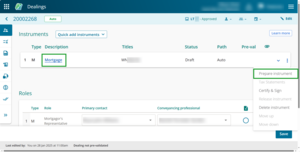
2: Choose the right mode for the mortgage instrument.
By default, Simple mode is selected for a mortgage instrument.
The mode type can be changed to Complex if the mortgage is:
- only affecting part of the land
- when dealing with only some of the mortgagors shares and/or interests on 1 or more titles, or
- when adding specific conditions or clauses to the instrument.
Prepare a mortgage in Complex mode
The mode type can be changed to Instrument when mortgaging another mortgage, encumbrance or other interest including lease or easement instrument.
Prepare a mortgage in Instrument mode
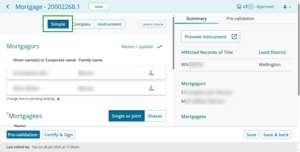
3: Check the Mortgagors are correct.
The registered owners for the affected titles will automatically display in the Mortgagor section.
The names of the owners may also reflect any change of ownership instrument prepared in the same dealing prior to the mortgage.

You can do the following actions with the mortgagors:
- change due to pending dealing
- revert or update mortgagor's names
- view additional information for the mortgagors.
Change due to pending dealing
Use the Change due to pending dealing toggle under the mortgagors to edit, add or delete the names displayed, including any additional information like aliases. For example, use when an instrument in a prior dealing is updating who the mortgagors will be, or when dealing with a protected (hidden) title or instrument.
You will need to confirm you want to modify the names before making any changes.
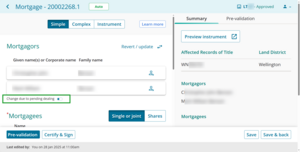
Revert/Update
Select the Revert/update button above the Mortgagors section to re-set the names to reflect the Register and any prior instruments in the dealing.
For example, if the name has been edited using Change due to pending dealing, it will revert to what is recorded on the Register. Or, if a prior instrument has been added to your dealing which changes the ownership, using Revert / update will pull through the updated names.
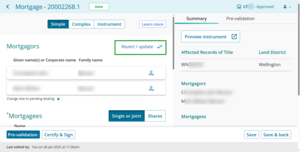
Additional Mortgagor details
To view other details such as an alias, suffix or birth date of a minor, select the person icon to the right of the mortgagor.
If the person icon is filled in blue there are additional details recorded for that Mortgagor.
To add, edit or remove details, turn on the Change due to pending dealing toggle, then select the person icon to make changes.
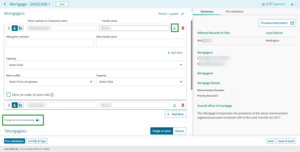
4: Select whether the Mortgagees are Single or Joint or Shares.
Select whether the Mortgagees are Single or Joint or Shares. The default setting is Single or Joint.
Use Single or joint for 1 or more mortgagees who will hold the mortgage solely or together.
Use the Shares button where mortgagees will hold the mortgage in shares or amounts.

5: Select or enter a Mortgagee.
Use the drop-down menu in the Name field to view a list of common mortgagees that have associated quick codes.
The most common lenders are listed first.
Either scroll down the list or start typing the lender's name to filter the available options.

Add a new mortgagee
For other mortgagees, such as private mortgagees, type the name directly into the Name field.
After entering the name of the mortgagee, select it from the drop-down menu to confirm your entry.
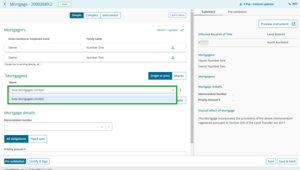
Add additional mortgagees, shares or create a Mortgagee group
Select the Add mortgagee to add a new mortgagee row.
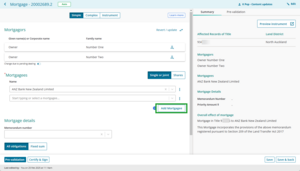
In Shares mode, an extra column appears where you can enter the shares each mortgagee will hold. You can enter the shares as a number, fraction or dollar value.
You can also select Add group to create a joint mortgagee group, where 2 or more mortgagees hold a share together.
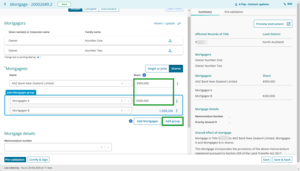
Three-dot menu
Select the 3-dot icon to the right of a mortgagee for a menu of additional options such as:
- Move mortgage up or down.
- Add a new joint mortgagee.
- Ungroup mortgagees.
- Delete row.
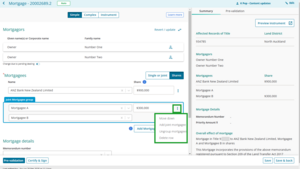
6: Select or enter the Memorandum number.
Use the Memorandum number field to look up a memorandum.
If the mortgagee has specific memoranda these will be listed first, followed by common or generic memoranda such as ADLS.
Either scroll down the list, which is arranged from newest to oldest, or start typing part of the memorandum number to filter available options.

7: Select either All obligations or Fixed sum and enter required information.
All obligations
By default, All obligations is selected.
Enter the Priority amount for the mortgage. You don't need to add a $ sign and the field accepts both numbers, characters and text.
This is not a mandatory requirement, however, it's commonly used. A pre-validation warning will display if the field is left blank.
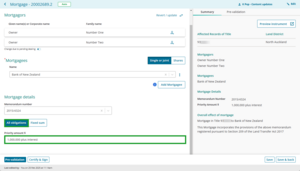
Fixed sum
At a minimum you must enter the principal sum amount in the Principal sum field. You don't need to add a $ sign.
Complete the other mortgage details if known.
Fields are free text so you can add any complex interest payment provisions. A limit of 250 characters is set per field.
Use the Additional Clauses, Conditions or Intent field to add any further text but note this will cause the instrument to step down to Lodge. The Summary will automatically update with the wording or you can use Preview Instrument to view the full instrument details.
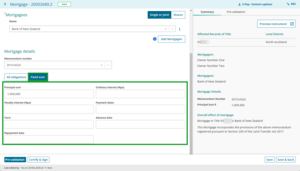
8: Preview the instrument.
The Summary tab will automatically update and display a read-only summary of some key details entered on the left-hand side of the page.
Use the Preview instrument button to view, print or download the full instrument preview, including any ‘Add Text’ fields, certifications and signatures.
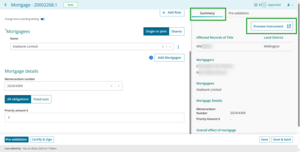
9: Save.
Select Save at the bottom right of the page to save the information and stay on the Prepare instrument page.
Select Save & back to save the information and return to the Instrument & Roles page.